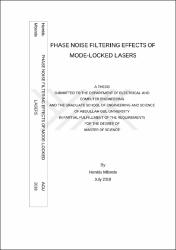| dc.contributor.author | MBONDE, HAMIDU | |
| dc.date.accessioned | 2020-07-21T12:46:36Z | |
| dc.date.available | 2020-07-21T12:46:36Z | |
| dc.date.issued | 2018 | en_US |
| dc.identifier.other | Tez No: 513765 | |
| dc.identifier.uri | https://hdl.handle.net/20.500.12573/311 | |
| dc.description.abstract | The subject of Mode-Locked Lasers has experienced a massive growth over the last two decades. Previously meant as the source of ultra-short optical pulses, its concepts have recently expanded to be applicable in areas beyond Optics such as Biomedical[1], Micro-machining[2], Sensing[3] and RF/Microwaves communication[4]. In particular this thesis focuses on application of Mode-Locked Lasers in RF/Microwave communications. One of the common problems with RF communication systems is signal integrity. Due to the nature of oscillation systems that are used to produce RF signals there is always an inevitable amount of undesirable signal associated with main signal being generated. These spurious (noise) signals have significant effect on the efficient performance of particular RF system. Low noisy RF signals are highly desirable and have many applications in high speed communication, RADAR and electronic warfare. Therefore it is critical to have an efficient means of producing low noise RF signals. Generating RF signals by Optical means has emerged as a major solution to this problem. Various methods for optically generating lower noise RF signals of high frequency have been developed such as frequency stabilized mode-locked lasers[5], phase locked loop based oscillators[6] and optoelectronic oscillators[7]. In this thesis a novel approach to this problem is presented, instead of generating lower noise signals a unique method of efficiently filtering the noise of RF signal using Mode-Locked Laser is explained. The first two chapters give brief introduction to mode-locked lasers and phase noise in oscillator, the concepts which will be used throughout this thesis. Then the experimental setups of the proposed system with the results obtained are presented in Chapter 3. Furthermore, theoretical study and analysis of limitations of this method is presented in ii Chapter 4. This includes analysis of these limitations as well as supporting simulations results. Phase noise is frequency domain term which in time domain is referred to as jitters. For various applications it is necessary to determine total jitters value of the system in order to estimate its bit error rates and other performance features. Chapter 5 of this thesis is dedicated to introducing jitter concept and a numerical method of converting a phase noise spectrum into jitter Probability Density Function (PDF).Together with the MATLAB code for aforementioned simulation a special GUI (Graphical User Interface) has been developed for the purpose of converting any given phase noise spectrum into its corresponding jitter PDF. The last chapter gives some concluding remarks and look at the possible futures of this work. | en_US |
| dc.language.iso | eng | en_US |
| dc.publisher | Abdullah Gül Üniversitesi | en_US |
| dc.rights | info:eu-repo/semantics/openAccess | en_US |
| dc.subject | Mode-locked Lasers | en_US |
| dc.subject | Phase Noise | en_US |
| dc.subject | RF(Radio Frequency) | en_US |
| dc.subject | Oscillators. | en_US |
| dc.title | Phase noise filtering effects of mode-locked lasers | en_US |
| dc.title.alternative | Kip-kilitlemeli lazerlerin faz gürültüsü filtreleme özellikleri | en_US |
| dc.type | masterThesis | en_US |
| dc.contributor.department | AGÜ, Fen Bilimleri Enstitüsü, Elektrik ve Bilgisayar Mühendisliği Ana Bilim Dalı | en_US |
| dc.contributor.institutionauthor | MBONDE, HAMIDU | |
| dc.relation.publicationcategory | Tez | en_US |


















